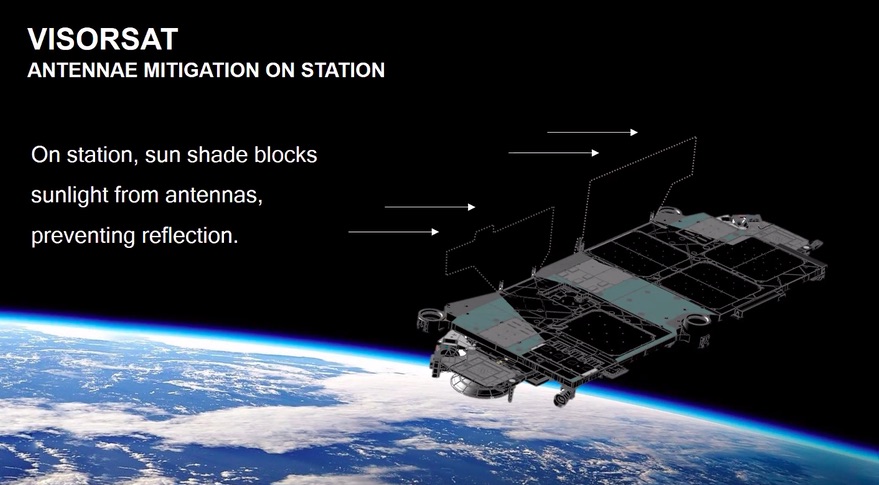Products You May Like
WASHINGTON — SpaceX Chief Executive Elon Musk said April 27 that he hopes to test a new way to reduce the brightness of the company’s Starlink satellites on the next launch for the broadband megaconstellation.
In a briefing to a committee working on the next astrophysics decadal survey, Musk said the experimental “VisorSat,” along with a new approach for orienting Starlink satellites as they raise their orbits, should address concerns raised by astronomers that the Starlink constellation could interfere with their observations.
“Our objectives, generally, are to make the satellites invisible to the naked eye within a week, and to minimize the impact on astronomy, especially so that we do not saturate observatory detectors and inhibit discoveries,” Musk said.
SpaceX first attempted to address the brightness problem with an experimental “DarkSat” included in a batch of Starlink satellites launched in January. The satellite used what the company described as experimental darkening treatments over reflective surfaces, like its antennas, in an effort to reduce the amount of sunlight it reflects and thus make it darker.
While DarkSat has shown some promise, appearing about one magnitude darker than untreated Starlink satellites, the company is moving in a different direction. “We found an option that is even better than that, which is basically to give the satellites shades,” he said.
Musk and others at SpaceX have previously discussed a sunshade that they compared to a patio umbrella that would deploy from a satellite, keeping the antennas in shadow. Musk, at the committee meeting, described a concept called VisorSat that would deploy panels, like sun visors mounted on a car windshield, to block the sun.
“We have a radio-transparent foam that will deploy nearly upon the satellite being released, and it blocks the sun from reaching the antennas,” he said. “They’re sun visors, essentially: they flip out and block the sun and prevent reflections.” He predicted that the visors would have a “massive effect” on the brightness of the satellites.
SpaceX is planning test VisorSat on the company’s next Starlink launch. “It’s a bit of a challenge, but that’s our goal,” he said. He didn’t say how many satellites would be equipped with visors, or when the launch was scheduled. SpaceX has been performing Starlink launches at the rate of at least one a month so far this year, most recently April 22.
A second effort involves the brightness of the satellites as they raise their orbits after launch. Musk said the satellites appear bright because of the orientation of the solar panels, which are aligned differently during orbit raising than once at their operational orbit.
As soon as this week, Musk said SpaceX will try an “orientation roll” to change the alignment of the solar panels relative to the Earth, reducing the amount of sunlight they reflect to the ground. “Early indications are this will have a significant effect on the brightness during orbit raise,” he said. “The satellites will be significantly less visible from the ground.”
The measures SpaceX has taken have come after months of discussions with astronomers, who have been worried about the effects a full constellation of Starlink satellites — about 12,000 according to current plans, with proposals for up to 30,000 more — would have on astronomy. The situation was of particular concern to those operating telescopes with wide fields of view, like the Vera Rubin Observatory under construction in Chile, where Starlink satellites would be visible in a large fraction of images taken each night.
In a separate presentation to the committee earlier in the day, Tony Tyson, chief scientist for the Rubin Observatory, said the concern was that the brightness of unmodified Starlink satellites would cause “nonlinear crosstalk,” or severe image artifacts, in the observatory’s camera. “We would be left with all of these fake trails, fake galaxies, etc., in our data, damaging the science,” he said.
SpaceX has already made progress darkening the satellites, with newer satellites about one magnitude darker than the original “v0.9” satellites launched in May 2019 even without the darkening treatments used on DarkSat. If the satellites can be made about a factor of two darker than DarkSat, Tyson said a technique to correct for the nonlinear crosstalk can work, although it is computer intensive and won’t correct for the original streak left in the images by passing satellites.
The new approaches won’t address the issue of brightness of existing Starlink satellites, but Musk said their lifetime is limited. He estimated the initial generation of satellites will be deorbited in about three to four years to make way for improved satellites. “We’ll just have far greater throughput capability with version two” of the Starlink satellites, he said.
While the focus of the committee presentation and subsequent discussion, which lasted for more than an hour, was on Starlink, there was some talk about the role SpaceX could play in supporting space-based astronomy, which is not affected by Starlink or other megaconstellations.
“I’m very excited about the future of space-based telescopes that could be very large,” he said. He mentioned Starship, the company’s next-generation large reusable launch system, which will begin regular flights “I think within a couple of years,” he promised. “It allows for space telescopes to be transported to orbit at probably an order of magnitude lower cost than in the past.”
“I’m pretty interested in trying to figure out how to help launch and possibly build a big observatory in space,” he said, offering to meet with astronomers to discuss mission concepts. “Like a planet imager or something like that.”
